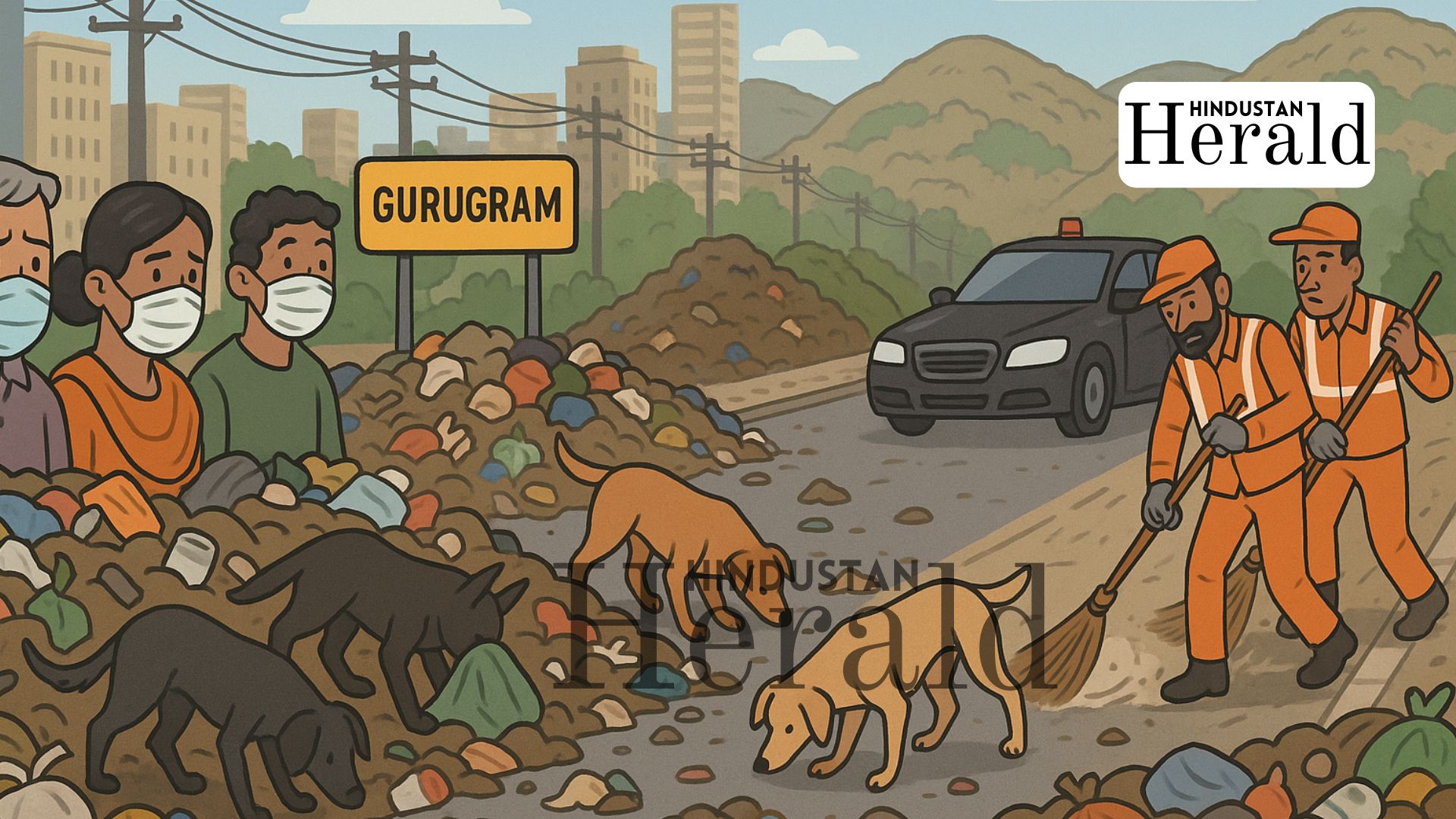Gurugram, October 9: Walk through Gurugram on a humid evening, and you’ll know the smell before you see the sight heaps of rotting garbage, flies, stray dogs tearing into black bags, and the slow, sticky air of a city that’s forgotten how to breathe. This is India’s “Millennium City”, still boasting of glass towers and smart-city promises, but choking on its own waste.
The Rot Beneath the Shine
Ask anyone living in the older parts of the city or even in its gleaming new sectors, and you’ll hear the same frustration. Garbage goes uncollected for days. Dumping spots keep growing like small mountains. And if someone from the Chief Minister’s office is expected to drive through, a flurry of last-minute sweeping begins, just long enough to fool a passing convoy.
“All the roads are suddenly being cleaned,” said one resident from Sector 45. “Two days later, it’ll all be the same again.”
Inside villages absorbed into the city, the stench is unbearable after sunset. Residents talk of garbage spilling into lanes, of hospital waste mixed with domestic trash. “Come to my room after five,” another local said, half laughing, half angry. “You won’t be able to stay for ten minutes.”
The irony is thick: Gurugram, with a cleanliness budget of nearly Rs 400 crore, has been struggling to keep up with the basics, collecting its own waste. The tender for door-to-door garbage pickup has been cancelled not once or twice, but five times. Every cancellation means another few weeks of chaos.
The numbers paint a bleak picture. The city generates around 1,200 tonnes of waste every day, of which only 900–1,000 tonnes reach the landfill in Bandhwari. The rest simply lingers on roadsides, near schools, behind apartment gates. Officials admit there are over 250 “vulnerable points” where garbage keeps piling up, no matter how many times it’s cleared.
A System Built to Fail
Gurugram’s waste crisis isn’t new. It’s a slow disaster that’s been gathering for years, fuelled by poor planning and the wrong incentives.
The Municipal Corporation still runs on what insiders call the “collection and transportation” model. Contractors are paid based on how much they collect and dump. The more they carry, the more they earn. There’s no reward for segregation, no pressure to reduce the load going to landfills. “You’re literally paying people to dump more,” said one waste expert.
The result: a perverse loop. Trucks run full every day. The landfill keeps growing. And nobody upstream is held responsible for what ends up there.
At the same time, civic monitoring has collapsed. One RWA president said the city pays for “45 cleaners on paper” in his sector, but if you actually count, you’ll find five.” The rest? “They exist only in files.”
In places where RWAs have stepped in, like RD City, which runs its own cleaning operations, the model has worked. Residents there pay less than what the Nagar Nigam used to shell out to contractors, and the area stays clean. But expanding such citizen-led systems across Gurugram needs trust, and that’s in short supply.
The Invisible Workforce
Behind every overflowing dump are the people who still try to make it wor,k the rag pickers and informal waste collectors who clean nearly 80% of the city. They’re not on government rolls, they don’t get benefits, and they’re rarely acknowledged.
When the Haryana government began cracking down on undocumented migrant workers earlier this year, hundreds of these labourers, many from Assam and Bengal, left the city overnight. The result was immediate. Garbage pickups slowed down, and mounds of waste appeared in days.
Experts say no waste system can function without bringing these workers into the formal fold. “They are the backbone,” one activist said. “You can’t clean a city while pretending its cleaners don’t exist.”
Paper Cities and Real Smells
Residents are quick to point out the strange duality of Gurugram, a place that builds expressways in record time, yet can’t manage a dustbin. “On paper, five roads have been made in our area,” said another resident. “In reality, maybe one. The same with cleaning. Everything looks good in documents.”
There’s a cynicism now, sharpened by years of neglect. People know that just before VIP visits, garbage disappears. Dumping grounds are covered with sheets or saplings. For a few hours, everything looks fine. Then the show ends.
“It’s all for the photo op,” said a member of a local civic group. “Once the cameras leave, the dumpers come back.”
The worst of it collects near Bandhwari, the city’s infamous landfill. For years, it’s been catching fire, methane leaks, untreated hospital waste, and untreated leachate that flow into nearby villages. Locals say their water has turned yellow and smells of chemicals. Studies have confirmed what they already know: the groundwater is poisoned.
A few kilometres away, Gurugram’s high-rises shimmer under corporate banners, a surreal contrast to the toxic mountain that feeds them.
Attempts at a Fix
The administration insists it’s working. The Haryana government has recently ordered more waste-collection vehicles and promised GPS tracking for trucks. The MCG has also drafted a new Solid Waste Management bylaw, proposing a five-bin system for segregation of biodegradable, non-biodegradable, sanitary, hazardous, and e-waste.
RWAs have been asked to submit suggestions. Fines for littering and illegal dumping will reportedly increase. Officials also talk of installing CCTV cameras near “vulnerable points” to catch habitual offenders.
But for many residents, these are familiar announcements of promises made before every election, or every viral video showing heaps of garbage. “It’s always temporary,” said one woman from Sector 23. “They clean today, and it’s back the next morning.”
A City at Crossroads
What’s striking about Gurugram’s waste story is that everyone seems to know the problem, and yet, nothing moves. Policy documents exist. Funds exist. People care enough to complain. But accountability dissolves somewhere in the middle.
Part of the problem, as one environmentalist put it, is mindset. “The government sees waste as a liability. Companies see it as a business. No one sees it as a public service.”
Until that changes, Gurugram’s garbage will keep making headline,s and residents will keep holding their noses.
The solutions aren’t complicated: decentralize processing, empower RWAs, bring informal workers into the system, and reward actual recycling instead of tonnage. But those require political will, not just press notes.
Indore and Pune have done it. Gurugram can too if it wants to.
The Smell of Our Choices
At its core, this isn’t just about trash. It’s about the intent of the administration, of contractors, and of citizens who toss waste into empty plots when no one’s watching.
“We all complain,” one resident admitted, “but we also throw.”
Maybe Gurugram’s real problem isn’t that it has too much garbage. It’s that too few people in power and out feel responsible for it.
Until that changes, the city will keep cleaning up for the next VIP visit, not for itself.
Stay ahead with Hindustan Herald — bringing you trusted news, sharp analysis, and stories that matter across Politics, Business, Technology, Sports, Entertainment, Lifestyle, and more.
Connect with us on Facebook, Instagram, X (Twitter), LinkedIn, YouTube, and join our Telegram community @hindustanherald for real-time updates.
Covers Indian politics, governance, and policy developments with over a decade of experience in political reporting.
Regional journalist bringing grassroots perspectives and stories from towns and cities across India.











